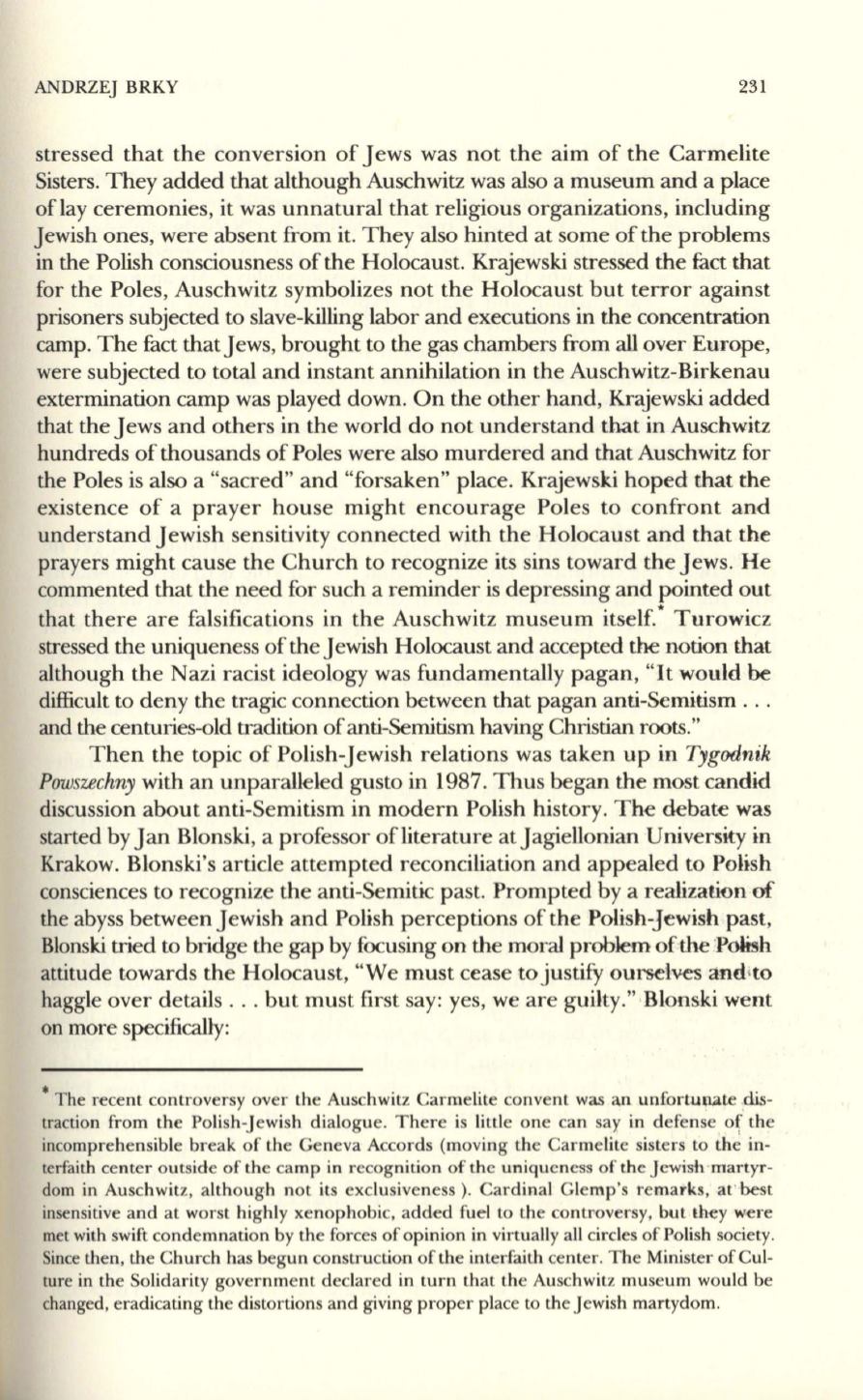
ANDRZEJ BRKY
231
stressed that the conversion of Jews was not the aim of the Carmelite
Sisters. They added that although Auschwitz was also a museum and a place
oflay ceremonies, it was unnatural that religious organizations, including
Jewish ones, were absent from it. They also hinted at some of the problems
in the Polish consciousness of the Holocaust. Krajewski stressed the fact that
for the Poles, Auschwitz symbolizes not the Holocaust but terror against
prisoners subjected to slave-killing labor and executions
in
the concentration
camp. The fact that Jews, brought to the gas chambers from
all
over Europe,
were subjected to total and instant annihilation in the Auschwitz-Birkenau
extermination camp was played down. On the other hand, Krajewski added
that the Jews and others in the world do not understand that in Auschwitz
hundreds of thousands of Poles were also murdered and that Auschwitz for
the Poles is also a "sacred" and "forsaken" place. Krajewski hoped that the
existence of a prayer house might encourage Poles to confront and
understand Jewish sensitivity connected with the Holocaust and that the
prayers might cause the Church to recognize its sins toward the Jews. He
commented that the need for such a reminder is depressing and pointed out
that there are falsifications in the Auschwitz museum itself.* Turowicz
stressed the uniqueness of the Jewish Holocaust and accepted
the
notion that
although the Nazi racist ideology was fundamentally pagan,
"It
would be
difficult to deny the tragic connection between that pagan anti-Semitism ...
and the centuries-old tradition ofanti-Semitism having Christian roots."
Then the topic of Polish-Jewish relations was taken up in
Tygodnik
Powszechny
with an unparalleled gusto in 1987. Thus began the most candid
discussion about anti-Semitism in modern Polish history. The debate was
started by Jan Blonski, a professor of literature at Jagiellonian University in
Krakow. Blonski's article attempted reconciliation and appealed to Polish
consciences to recognize the anti-Semitic past. Prompted by a realization of
the abyss between Jewish and Polish perceptions ofthe Polish-Jewish past,
Blonski tried to bridge the gap by focusing on the moral problem of the 'PoIish
attitude towards the Holocaust, "We must cease to justify ourselves and<to
haggle over details ... but must first say: yes, we are guilty." Blonski went
on more specifically:
• The
~ecent
controversy over the Auschwitz Carmelite convent was an unfortunate
.dis–
traction from the Polish-Jewish dialogue. There is little one can say in defense of the
incomprehensible break of the Geneva Accords (moving the Carmelite sisters to the in–
terfaith center outside of the camp in recognition of the uniqueness of the Jewish 'martyr–
dom in Auschwitz, although not its exclusiveness). Cardinal Glemp's remaTks, at' best
insensitive and at worst highly xenophobic, added fuel to the controversy, but they were
met with swift condemnation by the forces of opinion in virtually all circles of Polish society.
Since then, the Church has begun construction of the interfaith center. The Minister of Cul–
ture in the Solidarity government declared in turn that the Auschwitz museum would be
changed, eradicating the distortions and giving proper place to the Jewish martydom.


